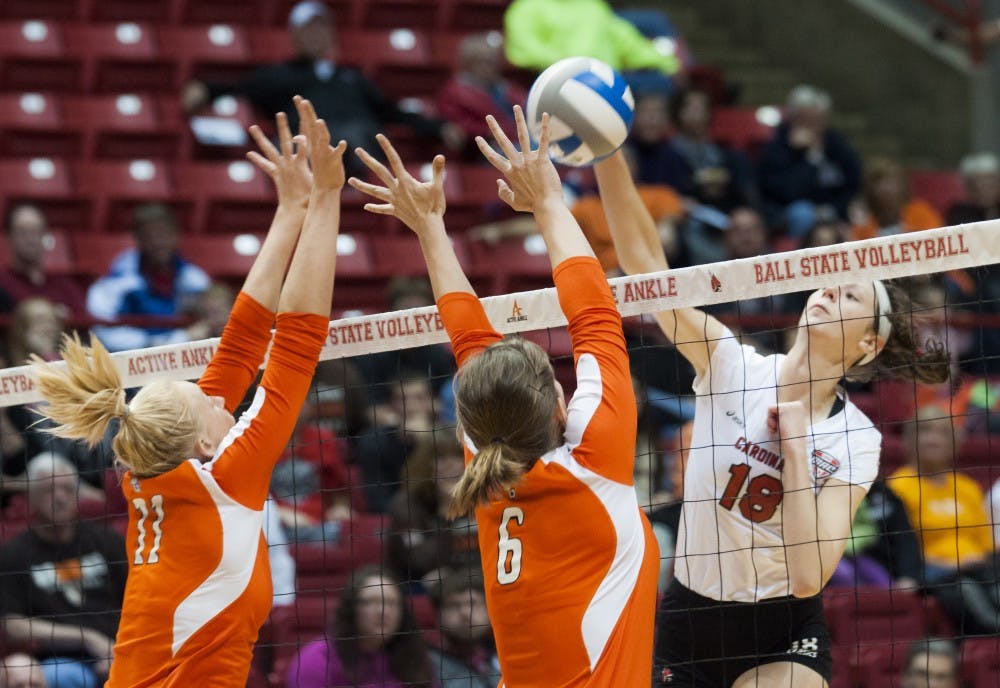After losing sophomore outside hitter Alex Fuelling in practice to a left ankle injury, the Ball State volleyball team knew it would have to adjust its strategy, which included using freshman Mackenzie Kitchel more.
That changed just minutes into the match, when Kitchel slammed into the ground and crumpled in pain.
Worthen Arena went silent as she was helped up and slowly proceeded off the court, putting no weight on her left leg.
“You fear the worst, and it’s a distraction — you’d be lying if you said it didn’t affect the way you play,” Ball State senior setter Jacqui Seidel said. “You’re concerned, it’s your teammates; you care about them, and it’s the heart of your team.”
Without two of its most important offensive threats, Ball State fell to Bowling Green State University 3-1 and often seemed lost on offense.
Heading into the match, Fuelling and Kitchel had combined for 37 percent of Ball State’s offense. Not having them on the court put a sizable dent into what has been one of the most deadly offenses in the Mid-American Conference, one that led the conference in kills.
Sophomore Kelly Hopkins was immediately inserted into the front row, but she struggled to get offense flowing. She didn’t receive a kill, but she committed five attack errors and didn’t see time after the second set.
Senior opposite hitter Lauren Grant had more success when Seidel started setting her up, finding holes and keeping the sets close. She finished with a team high of 17 kills.
Even that wasn’t enough to overcome the injuries.
“Unfortunately, we had to put two girls out there who haven’t practiced out there all season so it changed dramatically,” Ball State head coach Steve Shondell said. “I thought Hopkins early on blocked a few balls, but she just couldn’t do anything offensively.”
Ball State looked timid and confused at times, players were unsure of when to step up and attack the ball. Attacks were weak and easily deflected or blocked by Bowling Green defenders, who finished with 27 block assists on the night.
The loss of offense was evident. Kitchel made her way out of the locker room at the start of the third set with her left lag wrapped.
She and Fuelling sat next to each other on the bench, crutches around them, the visuals constantly reminding the team of the grim situation they faced without two of its strongest hitters.
“It’s a distraction, but it can also help strengthen your team,” Seidel said.
After losing the second set and trailing overall 0-2, Ball State turned to sophomore Jenna Spadafora in hopes of resurrecting the offense.
Normally a setter, Spadafora played outside hitter last season because of injury problems to other players.
The team found the offense it needed, and Spadafora led the team to a 25-14 win in the third set to keep the team’s hopes alive. She finished with eight kills, but looked more aggressive offensively than the rest of the team.
“She was our savior,” Seidel said. “She came in with confidence and knew she could do the job, and we believed in her as well.”
The spark provided was quickly doused by Bowling Green, who jumped out to a 9-1 lead to start the fourth set, quickly silencing the crowd at Worthen Arena.
Bowling Green began shifting the block toward Spadafora, understanding that she was Ball State’s main weapon on offense. Attacks that were finding open spots were suddenly blocked, leaving nowhere for her team to turn.
Without her to provide offense, Ball State ran out of gas.
“When you lose two key players in 48 hours, mentally, it just shakes you — it shook me,” Shondell said. “I’m sure our girls felt that way. … It just changes everything.”
Shondell said he expects Spadafora to start as an outside hitter against Miami University on Saturday.
The match begins at 7 p.m. at Worthen Arena.





